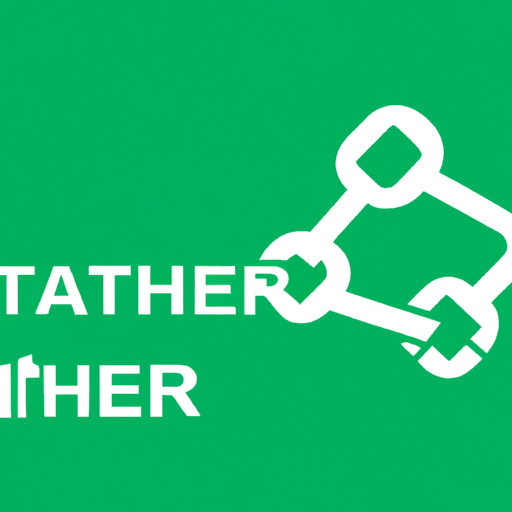
Tether is a significant player in the digital currency market. This blog post provides an extensive overview of Tether, its operations, and its usage around the globe. It delves into the intricacies of how Tether functions, the benefits and risks associated with it, and how people worldwide utilize it for various purposes.
Understanding Tether: What is it?
Tether is a type of cryptocurrency that serves as a bridge between traditional fiat currencies and the digital world. It was introduced in 2014 with the aim of providing stability to the volatile cryptocurrency market. Unlike other cryptocurrencies like Bitcoin or Ethereum, Tether is designed to maintain a 1:1 ratio with a specific fiat currency, most commonly the US dollar. This means that for every Tether token in circulation, there is an equivalent amount of US dollars held in reserve.
Tether operates on a blockchain technology known as Omni Layer, which allows for the secure and transparent transfer of Tether tokens. It is built on top of the Bitcoin blockchain and has gained popularity due to its ability to provide stability and liquidity to cryptocurrency exchanges. Tether tokens, symbolized as USDT, can be bought, sold, and traded on various cryptocurrency platforms.
One of the key features of Tether is its claim to offer stability in an otherwise highly volatile cryptocurrency market. By pegging its value to a fiat currency, Tether aims to provide a sense of security and predictability to users. This stability makes it a popular choice for traders and investors who want to hedge their cryptocurrency holdings against market fluctuations.
Moreover, Tether offers the advantages of quick and low-cost transactions, making it an attractive option for individuals and businesses involved in cross-border transactions. With Tether, users can easily transfer funds across different exchanges or wallets without the need for traditional banking intermediaries. This feature has contributed to Tether’s widespread adoption and its role in facilitating global financial transactions.

An illustration displaying the Tether logo and its connection with blockchain technology.
“Stability in the volatile world of cryptocurrencies”: How does Tether manage this feat?
Tether manages to provide stability in the volatile world of cryptocurrencies through several key mechanisms.
- 1. Backed by Fiat Reserves:
One of the primary ways Tether achieves stability is by being backed by fiat currency reserves. For every Tether token in circulation, there is an equivalent amount of fiat currency held in reserve. This means that, in theory, each Tether token has a tangible value that is tied to a specific fiat currency, such as the US dollar. This backing provides users with confidence that the value of Tether will remain stable, even in the face of market fluctuations. - 2. Regular Auditing:
To ensure transparency and maintain trust, Tether undergoes regular audits to verify the amount of fiat currency held in reserve. These audits are conducted by reputable accounting firms, and the results are made public. By providing evidence of their reserves, Tether aims to assure users that the stability of their tokens is based on real-world assets. - 3. Market Liquidity:
Tether’s stability is also maintained through its high liquidity. Being one of the most widely accepted cryptocurrencies, Tether is available on numerous cryptocurrency exchanges and platforms. This broad acceptance ensures that there is a constant demand and supply for Tether, allowing users to quickly convert their holdings into fiat currencies or other cryptocurrencies. This liquidity contributes to the stability of Tether’s value, as users can easily enter or exit positions without causing significant price fluctuations.
Tether and the Global Economy: What’s the impact?
The impact of Tether on the global economy cannot be understated. As a stablecoin, Tether offers a bridge between the world of traditional finance and the emerging cryptocurrency market. Its stability and ability to maintain a fixed value against fiat currencies make it an attractive option for individuals and businesses alike.
First and foremost, Tether provides a valuable tool for cross-border transactions. With traditional banking systems, international transfers can be slow and expensive. Tether’s digital nature allows for near-instantaneous transactions at a fraction of the cost. This has the potential to revolutionize global trade, facilitating faster and more efficient cross-border payments.
Additionally, Tether’s stability offers a hedge against inflation and economic volatility in countries with unstable currencies. In regions where hyperinflation or political instability pose a threat to traditional currencies, Tether provides a reliable alternative for preserving wealth and conducting transactions. This can empower individuals and businesses to protect their assets and maintain economic stability in uncertain times.
Furthermore, Tether’s widespread acceptance in the cryptocurrency market has facilitated the growth of decentralized finance (DeFi) applications. DeFi platforms, such as lending and borrowing protocols, rely on stablecoins like Tether as a means of collateralizing loans and maintaining stability within their systems. The availability of Tether as a stablecoin option enables the development of more sophisticated financial products and services within the decentralized financial ecosystem.

A world map showing countries where Tether is predominantly used.
Is Tether the future of digital transactions?
As the world becomes more digitized and interconnected, the question arises: Is Tether the future of digital transactions? While it is impossible to predict the future with certainty, Tether’s features and capabilities certainly position it as a strong contender in the evolving landscape of digital transactions.
One of the key advantages of Tether is its stability. Unlike many cryptocurrencies that experience significant price fluctuations, Tether maintains a fixed value against fiat currencies. This stability makes it an attractive option for everyday transactions, where individuals and businesses require predictability and reliability.
Moreover, Tether’s widespread adoption and integration into various platforms and exchanges further solidifies its potential as a future digital transaction solution. Its compatibility with major cryptocurrency exchanges and availability as a trading pair for numerous cryptocurrencies ensures its liquidity and accessibility.
The transparency and security of Tether’s operations also contribute to its potential as a future digital transaction leader. Tether has implemented measures such as regular audits to ensure that its reserves match the issued tokens, enhancing trust and confidence among users.
Furthermore, Tether’s ability to facilitate cross-border transactions seamlessly and at a lower cost compared to traditional banking systems positions it as a viable solution for global commerce. With increasing globalization and the rise of e-commerce, the demand for efficient and cost-effective cross-border transactions is only expected to grow, potentially benefiting Tether’s adoption.
However, it is important to note that Tether is not without its controversies. Concerns have been raised regarding its reserves and the extent to which it is backed by real assets. Regulatory scrutiny and ongoing developments in the cryptocurrency space may also impact its future trajectory.
Tether has undeniably carved a niche for itself in the digital currency landscape. Despite some controversies, its value proposition of offering stability in the volatile cryptocurrency market stands strong. As the world becomes increasingly digital, the usage and acceptance of Tether are expected to grow exponentially.
Recent Comments